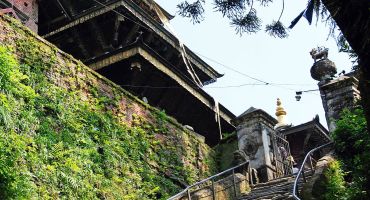Gum Baha or Gum Bahal or Gum Vihara is a sacred shrine of the Hindus and Buddhists located at Sankhu, 17 kilometeres to the north-east of Kathmandu. Today, the Shrine has a temple called the Vajrayogini, dedicated to Ugra Tara, arguably brought to Nepal in the 14th century by Bengali monks. But its origin is more ancient than what is deemed by most people.
Historian Dhanavajra Bajracharya is of the opinion that this place had a temple that was established during the Kirati era. He points out to the word “Gum” which is of Kirati (non-Sanskrit) origin meaning “Forest”. Gum Vihara naturally translates into “Forest Monastery”. Gum Vihara also finds mention in the Gopalarajavamshali which says,
“Manadeva…mahaghorapapa kritena maharodamana bhramitva Gum Vihara Sikhare tapa kritan. Tapu prabhavanmahachetamutpaddyate pratisthitasca.”
“Due to the sin committed by Mana Deva, he sat meditating in Gum Vihara. As a result a great Chaitya was created and consecrated”

It can be inferred that when the 6th Lichavvi King Manadeva ascended the throne, Gum Baha was already an established religious site. The Hadigaon excavation, which was crucial in establishing the evidences of a Kirata dynasty in Nepal came across an inscription of the Lichhavi King Amshuverma. The inscription describes the donations granted by the ruler to the prominent Viharas. The Viharas were given grants of 6 Purana 2 pana which is equivalent to the grant amount that was designated to Pashupati Nath. The fact that the same of amount of grant was given to Gum Vihara as that of the most prominent temple in all of Nepal proves that Gum Vihara must have been a highly revered site during this period.
Spiritually powerful places of Kirati origin in the Nepal valley are placed in locations that command geomantic perfection. Ancient Kiratis understood the focal points of natural energy and chose spots and topography such as hill tops, phallic peaks, crags, confluence of rivers and natural amphitheaters. One perfect example is the ancient site of Galdang-guldung Thang.kuh ( Pubung, Darjeeling), an assortment of caves that sit on a natural amphitheatre. Unlike present day Mangkhims that are built without any consideration for focal points or cardinal directions, ancient power places built by the Kiratas fulfill that criteria. Gum Bahal’s location too, points to this same practice as it sits atop a hill that acts like a center of a circle open on all sides and fairly above levelled ground, which could also be a feature that might have attracted the Vajrayana Buddhists to this place initially.

The origin of the Newari Shaman, Gubaju can also be traced back to Gum Baha. A person who derives his powers from Gum Baha essentially becomes a Gubaju. The fact that ancient Shamans considered this place to have spiritual power also logically points out to Gum Baha’s enormous religious relevance during the Kirati period in Nepal. Since it might have been a spiritually powerful place, one where potent divine spirits would thrive – could it have been an established ancient Mangkhim?





Leave a Reply